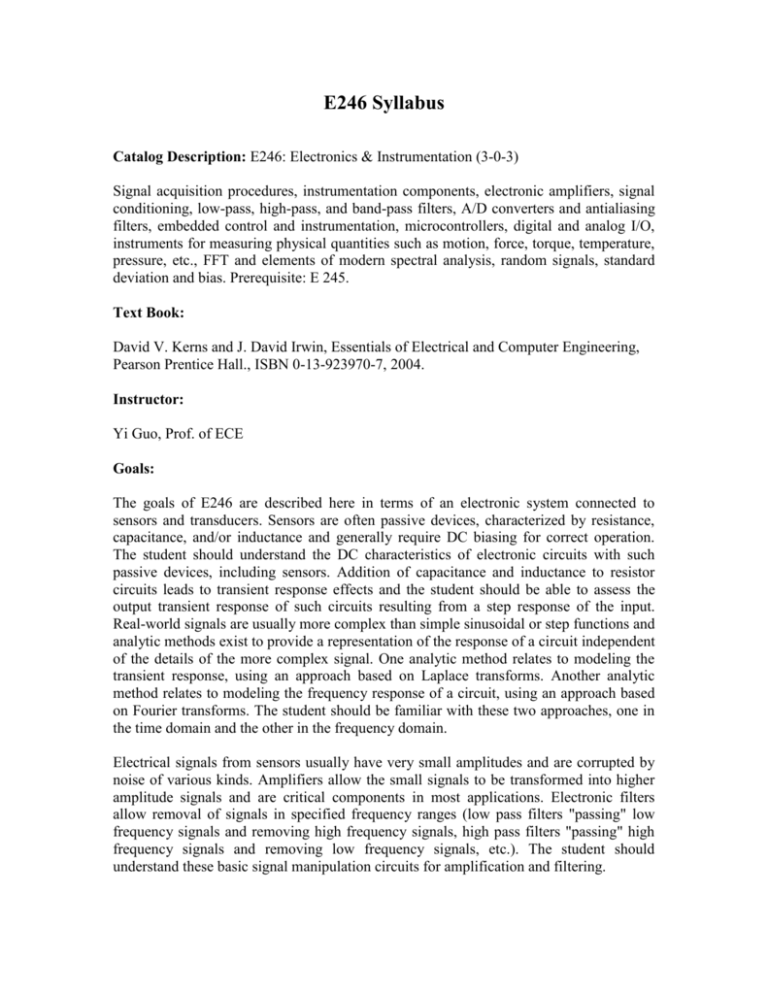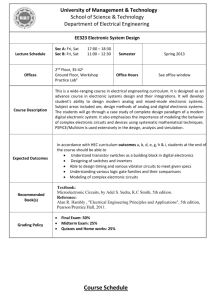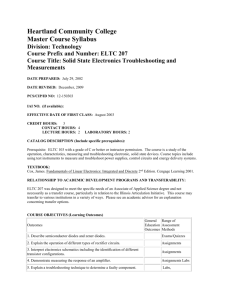
E246 Syllabus
Catalog Description: E246: Electronics & Instrumentation (3-0-3)
Signal acquisition procedures, instrumentation components, electronic amplifiers, signal
conditioning, low-pass, high-pass, and band-pass filters, A/D converters and antialiasing
filters, embedded control and instrumentation, microcontrollers, digital and analog I/O,
instruments for measuring physical quantities such as motion, force, torque, temperature,
pressure, etc., FFT and elements of modern spectral analysis, random signals, standard
deviation and bias. Prerequisite: E 245.
Text Book:
David V. Kerns and J. David Irwin, Essentials of Electrical and Computer Engineering,
Pearson Prentice Hall., ISBN 0-13-923970-7, 2004.
Instructor:
Yi Guo, Prof. of ECE
Goals:
The goals of E246 are described here in terms of an electronic system connected to
sensors and transducers. Sensors are often passive devices, characterized by resistance,
capacitance, and/or inductance and generally require DC biasing for correct operation.
The student should understand the DC characteristics of electronic circuits with such
passive devices, including sensors. Addition of capacitance and inductance to resistor
circuits leads to transient response effects and the student should be able to assess the
output transient response of such circuits resulting from a step response of the input.
Real-world signals are usually more complex than simple sinusoidal or step functions and
analytic methods exist to provide a representation of the response of a circuit independent
of the details of the more complex signal. One analytic method relates to modeling the
transient response, using an approach based on Laplace transforms. Another analytic
method relates to modeling the frequency response of a circuit, using an approach based
on Fourier transforms. The student should be familiar with these two approaches, one in
the time domain and the other in the frequency domain.
Electrical signals from sensors usually have very small amplitudes and are corrupted by
noise of various kinds. Amplifiers allow the small signals to be transformed into higher
amplitude signals and are critical components in most applications. Electronic filters
allow removal of signals in specified frequency ranges (low pass filters "passing" low
frequency signals and removing high frequency signals, high pass filters "passing" high
frequency signals and removing low frequency signals, etc.). The student should
understand these basic signal manipulation circuits for amplification and filtering.
Digital electronic circuits play an increasingly important role, including digital circuits to
make decisions based on the state of the overall system and "digital signal processors."
Digital signal processing replicates the functionality (filtering, amplification, modulation,
etc) of analog circuit through use of mathematical operations on numerical values of an
analog signal at regular time intervals. Addition of digital circuitry allows the
functionality of the system to be extended well beyond that of purely analog circuitry, for
example by adding software functionality using microprocessors/microcontrollers. The
student should understand the basic principles of digital circuits and have an appreciation
of the role of digital signal processing in contemporary systems.
Underlying the rapid expansion of the role of electronics is the rapid evolution of
semiconductor electronics to more complex circuits. An "integrated circuit" (IC) is an
electronic circuit fabricated on a small (about 1x1 cm) semiconductor "chip". Every 18
months, the amount of circuitry that can be provided on one of these IC chips doubles,
providing an enabling force allowing increasingly sophisticated electronics to be used
within overall systems. The student should appreciate the semiconductor technologies
and their use in basic circuits.
Grading Policy:
Homework 30%
Mid-term Exam 30%
Final Exam (comprehensive) 40%
No make-up tests. No late homework. In extreme situations, written requests must be
submitted beforehand. Possible revision of grades may be discussed within one week
from the return of the grades
Course Components:
Engineering - 80%.
Science and Math - 20%
Course Web Site: http://personal.stevens.edu/~yguo1/teaching.html
Schedule of Topics (tentative):
Week 1 - Review of Basic Electronics - Part I
Reading assignments:
Chapter 1: Introduction
Chapter 2: Sections 2.1 - 2.8.
Week 2 - Review of Basic Electronics - Part II
Reading assignments:
Chapter 2: Sections 2.9 - 2.11.
Chapter 3: Sections 3.1 - 3.4.
Week 3 - Review of Basic Electronics - Part III
Reading assignments:
Chapter 4: Sections 4.1 – 4.3, 4.5, 4.7-4.12.
Week 4 - Frequency Domain Analysis
Reading assignments:
Chapter 7: Sections 7.1 - 7.4.
Week 5 - Operational Amplifiers
Reading assignments:
Chapter 9: Sections 9.1 - 9.12.
Week 6 - Electronics Overview
Reading assignments:
Chapter 8: Sections 8.1 - 8.7 .
Week 7 - Semiconductor Devices
Reading assignments:
Chapter 10: Sections 10.1 - 10.4, 10.5.1, 10.5.2 (Basics of Diodes).
Week 8 – Transistor fundamentals
Reading assignments:
Chapter 11: Sections 11.1 - 11.4.
Mid-term Exam.
Week 9 - Digital Combinational Logic Circuits
Reading assignments:
Chapter 13: Sections 13.1 – 13.5.
Week 10 - Digital Combinational Logic Circuits
Reading assignments:
Chapter 13: Sections 13.6 - 13.8.
Week 11 - Intro to Digital Systems
Reading assignment - Sequential Circuits:
Chapter 13: Sections 13.9
Chapter 14: Sections 14.1 – 14.2.
Week 12 - Intro to Digital Signal Processing
Course Notes: Brief Introduction to Digital Signal Processing and Processors
Week 13 - Looking at an Example
Course Notes: This week, the design of an example system incorporating the
various topics covered in the course will be presented. The presentation will
include an overview of steps involved in design along with a review of principles
of embedded systems combining analog and digital functions.
Week 14 - Course Material Review:
Depending on wishes of students, the final exam may be given during the last
week of classes.
Homework Assignment:
No.
1
2
3
4
5
6
7
Assignment
2.39, 2.45, 2.52, 2.59, 2.70, 2.73
4.11, 4.41, 4.47, 4.59
7.2, 7.7, 7.14
9.16, 9.22, 9.32
10.20, 10.21, 10.22, 10.23, 10.24
11.20, 11.28
13.13, 13.16, 13.20, 13.28, 13.32, 13.37
Due date will be announced in class.






